Finding the Value in "Low Grade" Wood
A long and insightful discussion, with photos, about how to use (and sell) wood that is officially graded low. June 18, 2009
Question
From Professor Gene Wengert, forum technical advisor:
I have been asked to write an article for Sawmill & Woodlot magazine about uses for low grade lumber. I have a lot of uses and ideas that I have seen and learned about from others over the years. But I wonder if perhaps you great people could share the ideas you have on uses for low grade lumber (hardwood or softwood). Thanks!
Forum Responses
(Sawing and Drying Forum)
From contributor N:
I live close to a medium sized value added business that does a lot of finger jointing and when times are good, they will take my low grade stuff. Times haven't been good for a while, though.
From contributor T:
Oak sawhorses, trellises, tomato cages, low tech low cost bridge decks, hunting blind material, horse stalls, fencing, taxidermy lumber for rustic mount boards (they like knotty woods), not too fancy benches for rustic uses, indoor wall paneling (they like knotty low grade wood because it's interesting instead of so perfect that it might as well be plastic laminate), support post cladding in homes, hay feeding boxes for horses, etc.
From contributor J:
I buy wood from the Amish mills in Ohio and end up with all grades, FAS to firewood. The lower grades are used for rustic furniture as much as possible (which, by the way, seems to be very fashionable now). Some is milled into "character" flooring - also very fashionable. I give the scraps to a fellow who makes wooden utensils and does very well at the crafts fairs. He gives his scraps to a pen turner who then gives what remains to a gal who makes wooden jewelry. About all that's left is the low-grade sawdust! I'm the only one in this food chain that pays cash money for the raw material, which, I guess, makes me a heck of a nice guy!
From contributor S:
The main wholesale use around here is for pallets. A local shop pays $.20 a bd ft for unsorted low grade 4/4. He rips them to 31/2" for stringers. He uses some of the off fall to make small pegs called turf stakes used when installing a new grass surface. Another shop pays $.34 but the boards have to be sorted by width and length and it costs me about $.04 for freight.
A local business makes grade stakes and tree stakes, but he is flooded with low grade from a big mill. Another local guy buys KD #3com and lower from a big mill for $.25 and makes flooring. I'm not sure if he has many orders right now. I bought low grade poplar that was stained from a big local mill and used it as siding on my pole building. It's holding up pretty good (I have a 2' roof overhang, so it stays pretty dry).
The big buyer of flooring lumber in our area has stopped buying. The market for low grade in all species is pretty much flooded right now. Lumber buyers won't even return phone calls. Small sawmills can develop local markets for things like fence boards and siding, but without a strong wholesale base, these unreliable markets will result in inventory buildup that ties up cash flow.
A big local mill sells a big pack of low grade miscut lumber that is thick and thin for $65. Some of these packs have over 1,000 sq ft.
The best market for low grade right now is RR ties. The buyers are paying a premium for oversized bridge and switch timbers. The regular 7x9 and 7x8 in oak average about $20 after the freight is paid.
PA put in a statewide building code a few years ago and so now all framing lumber in inspected buildings must be grade stamped. Using unapproved lumber in agricultural buildings is still okay.
From contributor A:
If I ever cut a low grade board and use it I will let you know. Grade is a lot like beauty, and is in the eye of the beholder. One man's trash is another's treasure. Finding a use is not hard, but finding the beauty and setting it free is a bit more of a challenge.
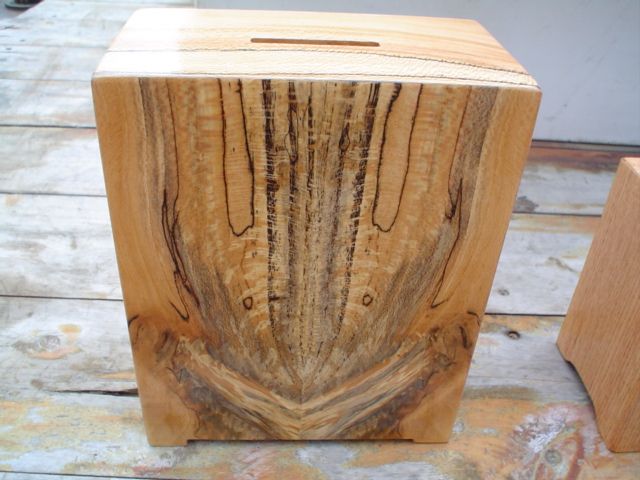
Click here for higher quality, full size image
From contributor E:
Nice bookmatch! What is the species? Sycamore spalted? Whatever it is, it is very hot!
From contributor J:
Contributor A is dead-on correct. What in the past would go to the burn pile is now premium wood (for some). Wormy maple is a good example, and ingrown-bark ash another example, which sells at a retail shop I know for fifty-six dollars/bf. However, Gene, if you're talking about moving units of low grade, I would be very interested in reading your article in the magazine! Thanks so much for your continuing input. All of us out here in cyberspace really owe you one.
From contributor O:
One more that I did recently was 2x2 dropped ceiling tiles. Planed and routed a v groove on some ambrosia maple. It made a good use of shorts and narrow stock. I used it in normal suspended ceiling grid, turning the blocks back and forth to make a basket weave look.
The one thing I thought of after the fact and have not resolved is whether I violated any fire codes. I think from my reading as long as the areas are under 1000 sf in each contained area of ceiling for residential, it's okay.
Here is some hickory wainscoting.
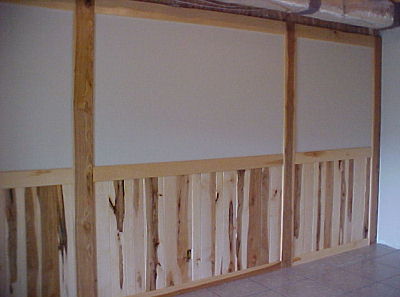
From contributor A:
Spalted sickymore, qsawn lumber.
From contributor W:
I truly would like to ask this question - please don't take this as argumentative: I become confused with the concept of grade. To what purpose was wood grading developed? I could guess that the grade standards were put into place to support the need or application. An example would be in boat construction, the wood needs to be able to be steam bent, be uniformly strong, and have no voids. If my guess is correct, then many applications could utilize low grade wood. The culture the wood is used in becomes the dominant factor, such as the days that red oak was king. It becomes the public's personal preference.
From contributor H:
I'm completing a kitchen remodel that is almost entirely from low grade, residential 2X construction scraps. I cut out defects, face on the jointer, square the edge, then run through the planer to achieve parallel faces. From here I rip to 7/8 slats then edge glue them together in appropriate sizes for the project. The outcome of this is a lot of quarter sawn material that looks gorgeous when finished properly.
From contributor A:
Grades and standards were set up so when folks from different areas talked with each other they were speaking the same thing. So it became more important with interstates and wider areas of shipping. Now if I list FAS qsawn lumber there should be no question in what you are getting. You might be hoping for all clear wood only to find a knot in the board. But by grade rules this would be allowed. However there would not be lots of wane, knots, or bug holes. Just like the standards for 2x4's and such. Just keeps us all on the same page.
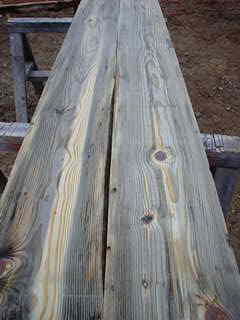
From contributor D:
Lumber grading is to make sure we throw things like walnut sapwood away (unless it is steamed... yuck) because it is so ugly.
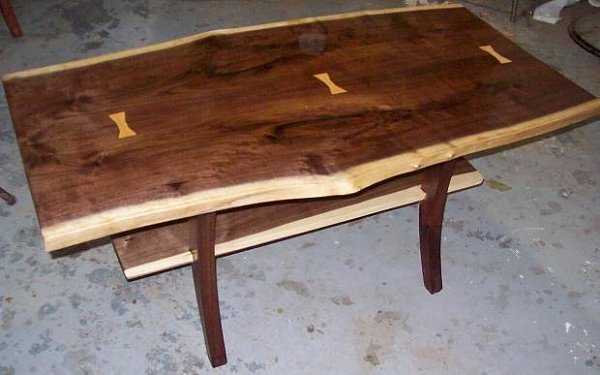
Click here for higher quality, full size image
And of course get rid of those nasty knots in boards too...
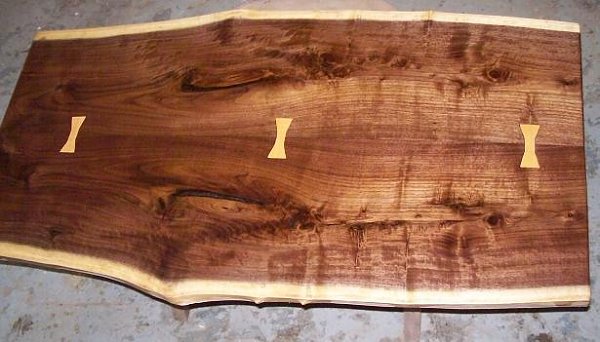
Click here for higher quality, full size image
From Professor Gene Wengert, forum technical advisor:
I appreciate all the comments so far. Indeed, I am trying to make a valuable product from what the grading rules would evaluate as low grade.
From contributor A:
Well Doc, I think contributor D did just that! He took that cull unsteamed junk and made it into a work of art.
From Professor Gene Wengert, forum technical advisor:
Me too. Isn't it a great piece?
From contributor D:
Ah shucks, just some "firewood" logs I found bucked into 4' lengths, talked the guys out of them for an equal load of mill slab. They had a heck of a pile of crotches thrown off to the side they didn't want to split... Like contributor A said, beauty (and value) is in the eye of the beholder.
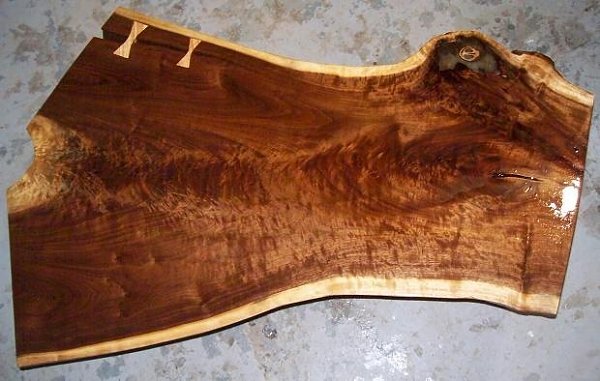
Click here for higher quality, full size image
From contributor J:
I'd like to add this thought to the topic, which probably will not be very welcome among all of us woodworkers. If you walk through an old growth forest that is preserved from logging, you will see a lot of low grade logs rotting on the forest floor. Maybe we should leave them be. Nature has her way, after all! I like spalt and wormy and weird as much as the next guy, but maybe we should leave some of it be. As far as your everyday crooked, knotty, ugly boards that come with any log-run package - how about sculpture?
From contributor N:
These are all really good uses for poorer grade wood, but how much demand is there for it? Could you sell 50 to 60,000 board feet of it a year? I cut a lot of Ponderosa pine. Mostly railroad ties. The nice 1 inch blue stained boards I dry in my kiln and make t & g. The rest is a real tough sell. Everyone wants Douglas fir. The two inch usually hangs around until the local finger joint mill can use it, and that can be a long time. Sometimes I can trade it for logs. But then, I'm not the greatest salesman. I guess what I'm trying to say is that in today's market, it is really tough to sell your poorer grade lumber in any sort of volume.
From contributor D:
If we are talking volume here, my input is somewhat weakened as a one man operation, maybe even pointless. I do see moving 50-60 mbft as a tough road for this kind of material... and hard to make any real profit selling it for the prices I have seen. I personally am not interested in volume. I found very early on milling that $10 bft lumber is the same labor/overhead as $1 bft stock - no-brainer. I think Gene was probably asking about higher volumes (?) to make milling on a larger scale more profitable. I just chimed in because there are niche markets that should not be overlooked. I have never cut a pallet board/RR tie/grade stake in my life, don't know the first thing about it even.
This "low grade" we are speaking of can be very profitable on a small scale (most likely on a large scale with proper marketing). It's all about your customers - customers you have to find, but that is the biz we are in. I have guys who will come into my shed and walk right past a pile with 1000 bft of FAS walnut and comment "nice looking stuff"... but keep walking. They are headed to the back for character wood with sap/knots/bug damage/spalt, stuff I used to throw over the hill while grade sawing. That crotch, for example, in a previous post of mine. I remember a transaction involving other flitches from the same crotch. A guy saw them stacked up in the back, asked "How much?" I just mumbled off a number, $100... he dug in his pocket and pulled out 4 - $50's like he was stealing my wood. The pieces were about 5 bft+/-, do the math. On the way back out he again glanced at the FAS pile, which I would have sold him all he wanted for $5 bft... off to the truck he went with his $20 bft wood instead.
That coffee table with the jointed bookmatch... that was limb wood, junk. I sell it for $12-$15 bft in sets like that rough sawn (after having just said my FAS is $5).
Sorry if I am not talking about the same subject that Doc brought up. But in this changing economy (many will tell you worsening), sometimes we have to change our market focus, and not just think volume at little or no profit margin. I don't want to sell 400,000 bft this year at $1 bft (or $.20 to a pallet company). I reckon I am just lazy, as 10,000 bft at $10-$20 from what was once considered "low grade" and in some circles still is, I guess is doable practically as a part time job.
From contributor J:
Excellent post! Perhaps you would be willing to share some secrets on finding those niche markets! Or have you been doing this long enough that they find you?
From contributor A:
Being a bit more in the production side of things (we do over 1 million bdft a year), there are things beyond one's control in production and the making of low grade lumber. It is a byproduct of making the main lumber.
But the logs like contributor D cut that table from are often left in the woods or cut into firewood (firewood is a needed product).
Marketing is the key to this. Just like folks get tired of FAS, they will get tired of figured wood. Only good craftsmen can work with wood that is not straight and clean. But if we cut it, we should use it. Pallets are needed as well as 3b flooring. Small chunks or shorts can be used but are hard to handle. Letting a tree rot in the woods is not a real waste, but we can not really afford to just let a forest age past its prime and destroy itself.
From contributor D:
No real secret to finding the niche markets. Web presence is a big part of it. Walk-in business for me is just not enough. (I will sell lumber from this thread, I guarantee it.) And being willing to ship that special piece to that special customer helps. Having a web presence helps me locally (200 mile radius) more than I ever thought it could. I live in an economically depressed rural area. 20% of my business is within 50 miles of me, and the other 80% is further still - some clear across the country.
I have been at this since 2004, not so long really. But for me running a manual band mill and being literally surrounded by Amish circle mills able to do in an hour what I can in a day, I knew to survive I was going to have to look for a niche. I did not want to grade saw oak for a few pennies profit per bft. Being a hack woodworker myself and having an appreciation for something different helped me reach customers.
Contributor A is a much larger operation than I, but his statement about low grade just being a fact of life is as about as right as rain... In the beginning I did not see the market for low grade and burned it. It pains me now to think of the $100,000's I burned. I only wanted the prettiest boards in my piles for sale. I would hide the ones with knots and sap at the bottom. Then guys started coming around and would dig all the way down to find something different. Not like what is shrink wrapped and bar coded at the big box - that is the fun of buying mill direct for many.
My customers find me now for the most part. What contributor A said about if we cut it, might as well use it - I agree. I don't sell exclusively low grade for obscene prices like I quoted in previous posts. I have graded lumber at the current market price and am fortunate to have a customer base that will at least buy the stuff that many mills would see as trash, since I sell to woodworkers. Some of the sales are for a premium, some are just sales that in past years when business was different would have been mill slab or firewood.
I am not even milling forest trees. I mill and sell only yard trees, have since day one. Many mills will not even consider sawing them, so I am really scraping the bottom of the barrel. I have a weird business model and would not ever try to explain it all, let alone suggest to someone looking to get into this to follow what I have done. But for some reason it has worked for me. I have a roof over my head and a full belly, go to work every day happy, and come home that way. That is all I ever wanted.
From contributor N:
I wish I could get a hold of some of the wood you guys have. We don't have any hardwood here. Doug fir is the highest value species but being in the semi desert area of British Columbia, the trees are a little too small to get much vg lumber. What I do have going for me is there is a large peeler mill in town and we can get their oversize blocks (8' plus trim) really cheap. Also the pine beetle is wiping out all our pine so that wood is cheap as well. But it's not high value wood so we have to work more on volume and the way the economy is now, it's tough enough selling the good stuff.
The finger joint mill owes me 10000 from a few months ago. I'm sure I'll get it - someday. And there are three or four log truck loads of beautiful spruce logs that I could get for cheap that they would usually take, but nobody's buying. It's nice to sell the character wood but we don't get much and we don't have the population base either. Our town has about 2000 people and the next towns are 45 minutes away and even smaller. But if it was easy, anyone would do it.
From contributor A:
Well, just drive down and I will fill your truck up. Then you will have the prettiest wood in town. Gots plenty and make more every day.
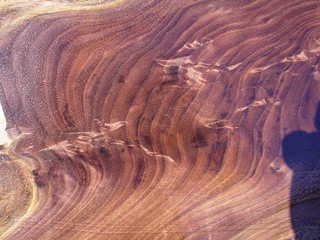
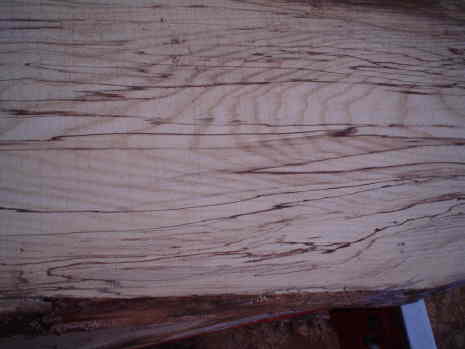
Click here for higher quality, full size image
From contributor K:
We are trying to specialize in rustic woods in our area. Here is a rustic cherry house we recently did. The wood is cheap yet is a bit more labor intensive to machine.
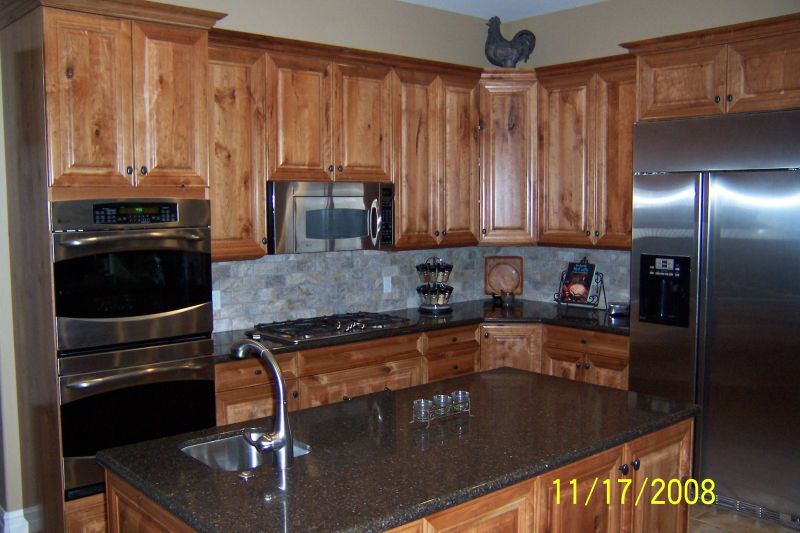
Click here for higher quality, full size image
From contributor W:
This is the third winter in a row that I have sorted through my piles and burned 2 common and less. Some of this wood has sat there for 20 years waiting for that worthy cause that will never come. In the mean time, it takes up valuable space. It was hard to do at first, but after three years I've convinced myself it is a good use of the material given the price of dry firewood.
From contributor R:
Sawmill has a lot of waste from the nucleus of a tree, 150 x 150 x 6000 mm. I land a vacuum drying and thermo F = 365. I get a new product which brings additional cost.
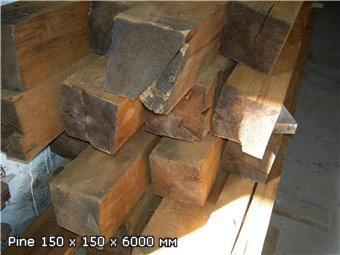
Used in the construction of houses.
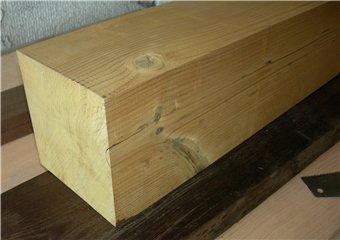
Birch departure production segment 27 x 90 x 300 mm. I do drying and thermodeking - sauna, terrace, garden, swimming pool.
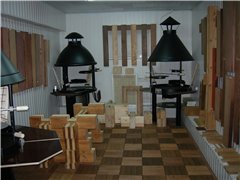
From contributor Z:
I have been sawing high grade logs out of some very nice trees. The rest of the tree is usually lower grade, so I've been thinking about selling leg stock out of maple, walnut and cherry.











